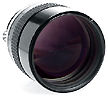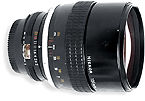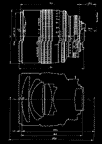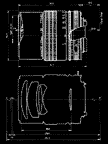In March 1977 all the three Nikkor lenses at 135mm has gone through a physical revamp. Together, they were being upgraded with an Automated Maximum Aperture Indexing coupling system at their rear section while a redesigned meter coupling prong were retained to enable them still be able to be used with older series of non-AI Nikon SLRs.
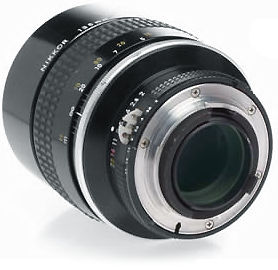 |
Now, what do all these info relative to this site ? Simple. Basically, it is necessary to understand some of the Nikkor 135mm telephoto lenses went through a confusing physical change to adapt the AI lens coupling but some lenses also had also revamp their optical design as well. As there were many of these older-spec Nikkor lenses being modified into an Ai-Spec lenses. Just be alert by avoiding buying into a modified non-AI lens version lens. |
|
Naturally, such differences may fetch a different premium (or discount) over lenses at used condition. Although as a general guide, most newer series of lenses usually have better design than previous ones, but such claims may not be always be the case. such as some users may even argue older AI Nikkor lenses have a better construction quality than newer Nikkor Ai-S lenses. But overall, I would still believe newer is always better. In the case of Nikkor 135mm telephoto lenses, virtually they have been greatly improved from older days of the non-AI AUTO Nikkor lenses. Newer series do have other considering factors such as a far more compact physical size, lighter in their overall weight and in some selective case, the newer ones have been designed to focus closer than older versions, for an example, in term of features, most Ai-Spec Nikkor telephoto lenses have a closer focusing ability to merely 1.3 m from 1.5m achieved by most older non-AI versions.
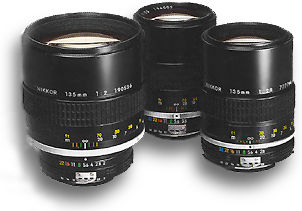 |
All of the three versions of 135mm Nikkor lenses share a practical built-in retractable lens hood design. Further, other than bulkier Nikkor 135mm f/2.0 lens which has a larger 72mm filter attachment size, both the f/2.8 and f/3.5 versions share a common filter attachment size of 52mm. Important ? Yeap, during those days, Nikon has maintained a uniform design for all Nikkor lenses from 20mm to 200mm to standard 52mm filter size. A good cost saving feature for consumers indeed. |
The high speed
Nikkor 135mm f/2.0 was literally upgraded DIRECTLY to include an AI lens coupling
system in 1977. It was again being upgraded in a straight forward Ai-S update in
December, 1981. Although the Ai-S version introduced at later stage has some minor
internal improvement done, both of these lenses have great similarities in their
optical design, weight and even in physical dimension. Serial number may have
been started from 190011 for this AI version Nikkor 135mm telephoto lens.
Specifications
Focal length/Aperture: 135mm f/2
Lens construction: 6 elements in 4 groups; Picture angle: 18°
Diaphragm: Automatic; Aperture scale: f2~ f/22 on both standard and aperture-direct-readout
scale
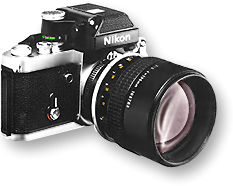 |
|
Exposure measurement: Via full aperture method; meter coupling ridge provided for Al cameras and meter coupling shoe for non-AI cameras |
Dimensions:
81mm dia. x 103mm long (overall); 93.5mm extension from flange
Attachment size: 72mm (P= 0.75); Front lens cap: Screw-in
Lens hood: Built-in; Lens case: CL-15; CL-62 *
When used with aperture smaller than f/11 with fast shutter speeds, there is occasional
uneven exposure. * Production Serial
Numbers for AI 135mm f/2.0 lenses are believed to have started from 190001 while
the same 6 elements in 4 groups design did has a pre-AI lens that started from 175011
(12/75 - 1977)
A major revamped occurred in April, 1976 for this Nikkor 135mm f/2.8 lens. The updated lens was actually formed the basis for the introduction of an equivalent AI lens in 1977. The optical formula of the AI-Nikkor 135mm f/2.8 which stands at 5 elements in 4 groups may have been sharing the pre-AI version (4 elements in 4 groups) which may have been introduced earlier between 1973-1975. The minimum aperture stops down to f/32 from f/22 as found in older version and its closest focusing distance improved to a closer 1.3m from 1.5m. It was also more compact and Nikon did a fantastic job by greatly reduce the weight of the lens down to merely 430g from a heavier 600g on previous pre-AI 1973-1975 lens model. The Ai-S version introduced during early '80 shares a similar optical design with this lens.
Specifications
Focal length/Aperture: 135mm f/2.8
Lens construction: 5 elements in 4 groups
Picture angle: 18°; Diaphragm: Automatic
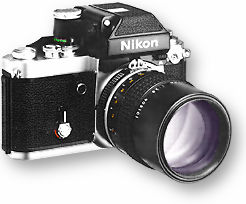 |
|
Aperture scale: f2.8~ f/32 on both standard and aperture-direct-readout scale |
Weight:
430g; Dimensions: 64.5mm dia. x 91.5mm long (overall); 83.5mm extension
from flange
Attachment size: 52mm (P = 0.75); Front lens cap: Snap-On
Lens hood: Built-in; Lens case: CL-32S; No. 62; CP-2 * When used with aperture smaller than f/11 with
fast shutter speeds, there is occasional uneven exposure. *
Production Serial Numbers for AI 135mm f/2.8 lenses are believed to be after March,
1977 and started from 770001; while the same 5 elements in 4 groups design did has
a pre-AI lens that started from 730001 (01/76 - 1977)
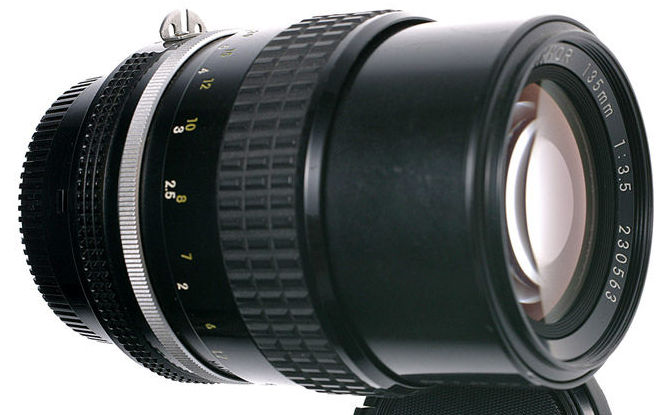 |
Credit: Image(s) displayed herein courtesy of all the nice folks from Taiwan's Digitize-Future@EBAY®. Some of them are extracted from their very popular online EBAY STORE. The Company also has a website on their own at shueido.com Image(s) copyright © 2006. All rights reserved. Please respect the visual property of the contributing photographer. |
It was believed the Ai-Spec Nikkor 135mm f/3.5 introduced during this period was employing a revised optical lens composition of 4 elements in 4 groups design from the 4 elements in 3 groups design used by the pre-AI version. A significant improvement with the new optical design was its close focusing ability which stands now at 1.3m from the 1.5m (5 ft.) provided by earlier version. It has also helped to reduce its weight by 55g (400g from 455g). The revamped optical formula used in this version was also being replicated in the A-S version introduced during the period in September, 1981. The NIC lens coating first used by the 1976 pre-AI version was believed to have been applied onto this version as well which may have contributed to its outstanding contrast and stable color fidelity.
Specifications
Focal length/Aperture: 135mm f/3.5
Lens construction: 4 elements in 4 groups
Picture angle: 18°; Diaphragm: Automatic
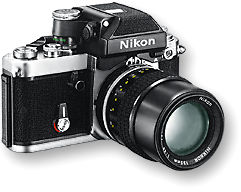 |
|
Aperture scale: f3.5~ f/32 on both standard and aperture-direct-readout scale |
Credit: Image ( left) of the Nikkor 135mm f/3.5 AI Telephoto lens displayed in this site courtesy of Mr Kevin J. Gorzynski® <BeSporty88@aol.com> Copyright © 2003. |
Weight:
400g; Dimensions: 65mm dia. x 89.5mm long (overall); 81.5mm extension
from flange
Attachment size: 52mm (P = 0.75); Front lens cap: Snap-On
Lens hood: Built-in; Lens case: U-32S; No. 62; CP-2; * Production Serial Numbers for AI 135mm f/3.5
lenses are believed to be after March, 1977 and started from 193501; while the 4 elements in 4
groups did has a pre-AI lens that started from 158101
 135mm f2.0s |
135mm f2.8s |
135mm f3.5s |
Back to | Main Index Page | of Nikkor 135mm Lenses |
| Message Board | for your Nikkor Optics in a shared environment
| Message Board | Specifically for Dispose or Looking for new/used Nikon/Nikkor photographic equipment
| Nippon Kogaku Rangefinder Resources | Nikon F | Nikon F2 | Nikon F3 | Nikon F4 | Nikon F5 | Nikon F6 | Nikkormat / Nikomat | Nikon FM Series | Nikon FE/ FA | Nikon EM/FG/FG20 | Nikon Digital SLRs | Nikon - Other models |
Nikon MF RF-Nikkor lenses for Rangefinder
cameras:-
Main Index Page
Nikon
Auto Focus Nikkor lenses:- Main
Index Page
Nikon
Manual
Focus
Nikkor lenses:-
Fisheye-Nikkor Lenses - Circular |
Full Frame |
Ultrawides Lenses - 13mm15mm18mm20mm |
Wideangle Lenses - 24mm28mm35mm |
Standard Lenses - 45mm 50mm 58mm | Telephoto Lenses
- 85mm105mm135mm180mm & 200mm |
Super-Telephoto Lenses - 300mm 400mm 500mm 600mm 800mm 1200mm |
 |
Special Application
lenses: Micro-Nikkor Lenses - 50mm~55mm -60mm 85mm -105mm 200mm Micro-Zoom 70-180mm Perspective Control (PC) - 28mm 35mm PC-Micro 85mm Dedicated Lenses for Nikon F3AF: AF 80mm f/2.8 | AF 200mm f/3.5 EDIF Depth of Field Control (DC): 105mm 135mm Medical Nikkor: 120mm 200mm Reflex-Nikkor Lenses - 500mm 1000mm 2000mm Others: Noct Nikkor | OP-Nikkor | UV Nikkor 55mm 105mm | Focusing Units | Bellows-Nikkor 105mm 135mm Nikon Series E Lenses: 28mm35mm50mm100mm135mm | E-Series Zoom lenses: 36~72mm75~150mm70~210mm |
MF Zoom-Nikkor Lenses: 25~50mm | 28~45mm | 28~50mm | 28~85mm | 35~70mm | 36~72mm E | 35~85mm | 35~105mm | 35~135mm | 35~200mm | 43~86mm | 50~135mm | 50~300mm | 70~210mm E | 75~150mm E | 80~200mm | 85~250mm | 100~300mm | 180~600mm | 200~400mm | 200~600mm | 360~1200mm | 1200~1700mm
Tele-Converters: TC-1 | TC-2 | TC-200 | TC-201 | TC-300 | TC-301 | TC-14 | TC-14A | TC-14B | TC-14C | TC-14E | TC-16 | TC-16A | TC-20E
Recommended links to understand more technical details
related to the Nikkor F-mount and production Serial Number:
http://rick_oleson.tripod.com/index-153.html by: my
friend, Rick Oleson
http://www.zi.ku.dk/personal/lhhansen/photo/fmount.htm by: Hansen,
Lars Holst
http://www.mir.com.my/rb/photography/hardwares/nikonfmount/lens2.htm
http://www.photosynthesis.co.nz/nikon/serialno.html
Recommended Reading Reference on Nikon cameras and Nikkor lenses | about this photographic web site
| | Back | Main Index Page of Nikkor Resources | Back | Main Index Page of Pictorial History of Nikon SLRs |
| Home - Photography in Malaysia |
![]() Co-developed
with my web buddy, Rick Oleson® &
Co-developed
with my web buddy, Rick Oleson® & ![]() Denmark, Creator of the Nikon
Repair Group Mailing-List;
A
contributing effort to Michael Liu's Classic Nikon SLRs and
Nikkor optic site.
Denmark, Creator of the Nikon
Repair Group Mailing-List;
A
contributing effort to Michael Liu's Classic Nikon SLRs and
Nikkor optic site.
Credit: MCLau®, who has helped to rewrite
some of the content appeared this site. Chuck Hester® who has been helping
me all along with the development of all these Nikon websites; Lars Holst Hansen, 'Hawkeye'
who shares the same passion I have; Ms Rissa, Sales manager
from Nikon Corporation Malaysia for granting permission to use some of the official
content; Ted Wengelaar, Holland
who
has helped to provide many useful input relating to older Nikkor lenses; Some of the references
on production serial numbers used in this site were extracted from Roland Vink's website; Hiura Shinsaku from Nikomat
Club Japan. Lastly,
to all the good people who has contributed their own expeience, resources or kind
enough granted permission to use their images of their respective optic in this site.
It is also a site to remember a long
lost friend
on the Net. Note:certain content and
images appeared in this site were either scanned from official marketing leaflets
& brochures published by Nikon and/or contribution from surfers who claimed originality
of their work for educational purposes. The creator of the site will not be responsible
for may discrepancies arise from such dispute except rectifying them after verification. "Nikon", "Nikkormat", "Nippon Kokagu
KK"
& "Nikkor" are registered
tradename of Nikon Corporation Inc., Japan. Site made with an Apple IMac.
